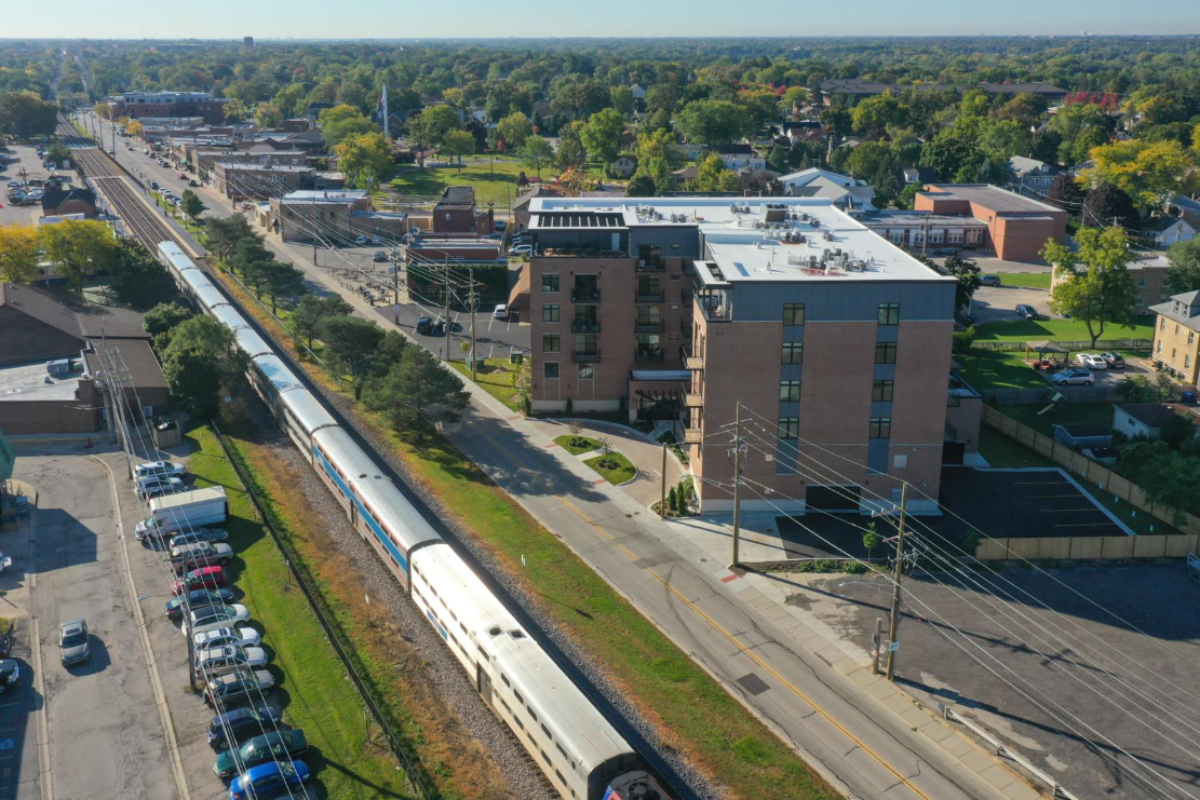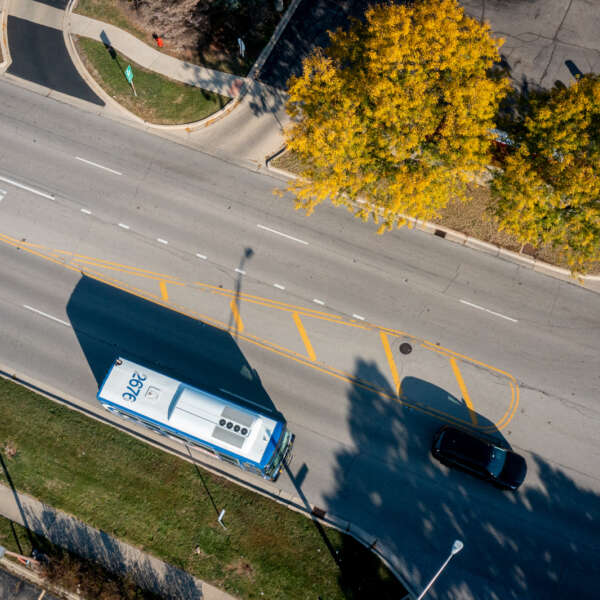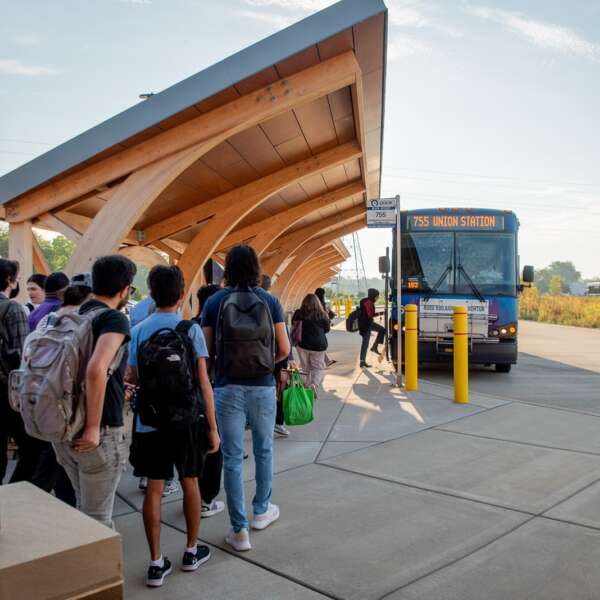RTA planning programs bring transit-oriented development progress to Chicago suburbs
March 8, 2023
March 8, 2023

The RTA’s Local Planning team provides support and funding opportunities to municipalities and transportation agencies across the region to improve transit access. This support comes in a variety of forms: re-writing zoning codes, convening developer panels, completing transit-oriented development (TOD) plans, and awarding funding for capital projects that improve pedestrian and bicycle infrastructure around transit stops. The RTA recently published three story maps highlighting case studies of TOD successes in Calumet Park, Bartlett, and Highwood. Explore recent changes in these communities and learn more about the role the RTA played.
The Village of Calumet Park is a community of more than 7,000 residents in the south suburbs of Chicago whose TOD planning efforts have led to significant investments in redevelopment projects near transit.
One of the key focus areas for the Village’s new Comprehensive Plan adopted in December 2020 was a vacant 6-acre site adjacent to the Village’s Ashland Avenue/Calumet Park Metra station. The Plan’s vision for the site was mixed use transit-oriented development with multi-family residential units, commercial/retail lots, green space, and a community gathering space. The Plan also recommended that the Village rezone this site from a “C2 – General Commercial” district to a “R2 – Multiple Family Residential” district, which would allow for the moderate density mixed-use development called for in the Plan.
With funding and technical assistance from RTA’s Community Planning program, the Village hosted a Developer Discussion Panel with four development professionals in June 2021. The panelists made a variety of recommendations on development requirements for the site, funding opportunities to pursue, and more.
The Village has made significant progress on implementing many of these recommendations. In July 2022, the Village announced that groundbreaking had begun on the site for a new development called the “Calumet Park Apartments.” The multi-phase development will include a 5,000-square-foot single-story medical facility and three four-story residential buildings, each with 56 housing units (168 units total). In addition, the development will include open green space for recreation. In October 2022, the Village announced that Metra had completed installation of station name signage that reflected the revised name for the station: “Ashland/Calumet Park.”
Calumet Park's success in implementing recommendations from the Comprehensive Plan have not been limited to land use, as the Village secured funding in 2020 and 2022 to finance the design and construction of pedestrian and bicycle facilities that provide connections to the Metra station. With support from the RTA through the Access to Transit Program, the Village was awarded roughly $475,000 in grant funds from the federal Congestion Mitigation and Air Quality (CMAQ) Program for these improvements.
The Village is using the funding for two separate projects that will enhance pedestrian and bicycle access to the Metra station: one primarily focused on Ashland Avenue and one focused on 124th Street. The Ashland Avenue project involves construction of approximately 2,050 linear feet of sidewalk along Ashland Avenue, new crosswalk striping across 124th Street, and covered bike parking at the Metra station. The 124th Street project involves construction of new sidewalk between Laflin Street and Bishop Street to close a sidewalk gap, ADA-compliant intersection improvements at the intersection of Laflin Street and 124th Street, and striping and installation of bicycle boulevard markings along 124th Street between Ashland Avenue and Halsted Street.
Currently the Village is working on finalizing Phase II Engineering drawings for each project. Construction on the 124th Street project is expected to be complete in summer 2023; the Village expects to complete construction on the Ashland Avenue project in November 2023.
Check out the story map to learn more.
The Village of Bartlett, a western suburb of Chicago with more than 41,000 residents, has made noteworthy progress on attracting commercial and residential investment following the adoption and implementation of their Downtown Transit-Oriented Development Plan in October 2016. With funding and technical assistance provided by the RTA’s Community Planning program, the plan aimed to increase economic development throughout downtown, encourage residents to use Metra, maintain and enhance the appearance of downtown, and promote a compact, walkable community. Since its adoption, the Village has advanced the plan’s goals by making investments in walkability, revising the zoning code, and supporting new business investment in downtown.
The Village’s recent investments in walkability include the adoption of a Complete Streets policy in June 2017, the development of a Bicycle and Pedestrian Plan with the neighboring Village of Streamwood (expected adoption in 2023), speed limit reductions on key roadways in downtown, and a series of sidewalk, curb ramp, and crosswalk projects.
Following its adoption of the Downtown TOD Plan, Bartlett enacted a new overlay zoning district for the downtown core area in 2019 with technical assistance and funding for the zoning amendment work provided by the RTA’s Community Planning Program. The new zoning overlay district established design regulations and streamlined the development approval process, which in turn helped to facilitate new commercial and residential investment that takes advantage of the Village’s location and transit access and development-friendly code requirements and processes.
Redevelopment projects include a new brewery and taproom (MORE Brewing), a restaurant/bar with an outdoor beer garden and performance stage (One Twenty Live), a wine bar/tapas restaurant (Le P’tit Resto Bar and Tapas), a mixed-use redevelopment with an office on the ground floor and residential above (113 Railroad Ave.), and a 90-unit residential project at the corner of Railroad Ave. and Berteau Ave.
Check out the story map to learn more.
Located roughly 25 miles north of downtown Chicago, the City of Highwood serves as a good example of how TOD planning and zoning amendments can help facilitate mixed-use development. With funding and technical assistance provided by the RTA, Highwood developed and adopted a TOD plan called the “Highwood Downtown Projects Guidebook” in September 2014. The Guidebook outlined a land use framework that sought to ensure that Downtown Highwood is supportive of transit, provides an appropriate mix of land uses, enhances safe and efficient multimodal access and circulation, and creates a distinct aesthetic that forms a brand and identity for the area.
The Guidebook identified a series of short- and long-term development opportunities in the downtown area and included development concept renderings and descriptions of proposed developments. In addition, the Guidebook recommended that Highwood review and revise its zoning code in the downtown area such that it aligned with the type of development proposed in the Guidebook and streamlined the development approval process.
In partnership with the RTA through the Community Planning program, Highwood adopted zoning amendments for downtown districts in 2017 that allowed for a greater mix of uses and specified design elements that would encourage walkability and consistent pedestrian-oriented urban design. These zoning changes catalyzed a variety of mixed-use development projects that were identified in the Guidebook, including mixed-use multifamily developments, a cannabis dispensary, a brewery and taproom, a coffee shop, and an ice cream shop. In addition, the City took initiative to purchase parcels in the downtown area that were in disrepair and are underutilized based on the new zoning regulations. The City intends to sell these properties to developers who are committed to delivering residential, office, and mixed-use projects.
In addition to the zoning recommendations, the Guidebook included a marketing plan that established new branding and signage for the City that replicated common design themes used by businesses in the area. The City subsequently created the “Celebrate Highwood” branding materials and the 501c3 special events organization of the same name, which operates the Village’s Pumpkin Festival, Nashwood Music and Food Fest, and other public events.
Check out the story map to learn more.
Subscribe to our Newsletter
Related Articles
 Coalition members provide feedback on ‘Transforming Transit,’ RTA’s vision for improved service and accountability
Coalition members provide feedback on ‘Transforming Transit,’ RTA’s vision for improved service and accountability
Nearly 200 riders, advocates, and other stakeholders met virtually with the RTA on February 11 for the sixth quarterly Transit is the Answer Coalition meetin...
February 20, 2025 Far South Halsted Corridor Study prepares for future Pace Pulse service
Far South Halsted Corridor Study prepares for future Pace Pulse service
An RTA Community Planning project kicked off in late 2023 as a crucial step in bringing Pace Pulse service to Chicago’s south suburbs. The Far South Halsted ...
February 19, 2025 RTA proposes reforms to prioritize capital projects, maximizing impact of funding
RTA proposes reforms to prioritize capital projects, maximizing impact of funding
RTA is proposing a historic restructuring of the region’s transit governance to maximize the impact of new operating funding and ensure all riders experience...
February 5, 2025 RTA proposes reforms to integrate fares, require accountability for faster and more reliable transit
RTA proposes reforms to integrate fares, require accountability for faster and more reliable transit
RTA is proposing a historic restructuring of the region’s transit governance to maximize the impact of any new operating funding and ensure all riders experi...
February 5, 2025 For the third year in a row, regional transit ridership was up by double-digits in 2024
For the third year in a row, regional transit ridership was up by double-digits in 2024
Ridership across the Chicago region’s transit system continued to increase throughout 2024, according to the latest data from CTA, Metra, and Pace. The regio...
January 28, 2025 RTA is seeking $1.5 billion in annual operating funding. What would that mean for your commute?
RTA is seeking $1.5 billion in annual operating funding. What would that mean for your commute?
On January 15, RTA released Transforming Transit, a vision for the regional transit system with $1.5 billion in annual operating funding supported by a stron...
January 28, 2025